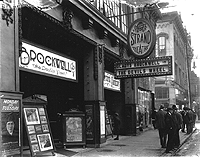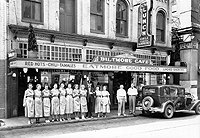
|
 |

This past year we got a good deal
of response to a three-month editorial-page experiment we called "Past Presence."
Basically, the idea was to take an interesting old photo—most of them
supplied from the vast archives of Thompson Photographic Products—and,
by using visible reference points, to take the picture again in 1997, from
as-nearly-as-possible exactly where the photographer stood. The results were
often striking; they show us, in stark relief, a Knoxville that's both gone
and somehow still there.
Many of these pictures tell their own stories, but we've tried to help them
along with a little research.
photographs by Aaron Jay
text by Jack Neely
 The Strand Theatre on Gay Street near
Wall Avenue in 1918, and today. The Strand Theatre on Gay Street near
Wall Avenue in 1918, and today.
Adorned with angelic cornice statuary, it opened as the "Gay Theater" in
1911, early in cinema history, but even so, it wasn't among Knoxville's first
movie houses; at least four were older. By 1918, the Strand with its oval
glass sign and comedy-mask logo was competing with seven other downtown
movie theaters. The feature advertised in the photo is called The Devil's
Wheel, starring Gladys Brockwell, a silent five-reeler now nearly forgotten.
An advertised coming attraction is the Klondike adventure, Rough and
Ready, starring William Farnum, "America's Most Popular Actor," and known
for its snowy fight scenes. In this silent era, a placard advertises "Wonderful
Music on our Photo Player by Frank Oglesby."

George's department store is in the background. The men loitering on the
curb are dressed in a mixture of formal suits and work clothes. The boy in
the cloth cap looking at the promotional stills appears to be about the same
age as future film critic and screenwriter James Agee, a 9-year-old who lived
in Knoxville at the time and knew this theater well.
The Strand closed in 1949. Today, 403-5 South Gay is vacant, and this boarded-up
corner is one of Gay Street's most desolate spots. Only one building, the
corner hat-and-shoe store next to the Strand, is visible in both photographs.
Its cornice work, visible above the Strand's marquee, is unchanged.
 When
Cherokee Country Club was founded on Lyons View Drive in 1907, it really
was a country club, well outside the western city limits. When
Cherokee Country Club was founded on Lyons View Drive in 1907, it really
was a country club, well outside the western city limits.
A Journal story reported the new resort's location as "five
miles below the city" by river; most of its members reached it that way.
Judging by the rare automobiles in the driveway, this photograph was taken
before World War I, probably not more than a couple of years after Cherokee's
opening. Though Knoxville proper was electrically illuminated by then, Cherokee's
elaborate clubhouse was to be gaslit. It featured a broad veranda, a mahogany
ballroom, billiard tables—and, in the basement, a bowling alley. Adjacent
was a nine-hole golf course. A golf tournament to coincide with the 1913
National Conservation Exposition required a $3 entry fee. (Tournament Chairman
was one McGhee Tyson, the pilot later killed in a World War I plane
crash.)
For Knoxville's wealthy, Cherokee also became a refuge from the city's new
prohibition laws, passed—not coincidentally, some believe—the same
year as Cherokee's opening.
This is how it appeared to poet Wallace Stevens, who walked here during a
business trip downtown in 1918 and described the club and golf course in
a letter to his wife. This is also how it appeared to Rose Williams, the
St. Louis heiress whose family held her debutante party here in 1926. Her
brother, playwright Tennessee Williams, believed an unfortunate incident
involving drunken college boys at Cherokee may have triggered her life-long
insanity. This building was replaced by the current structure, built behind
the site of the original, in 1928.
 According to a 1934 promotional brochure,
the Biltmore Cafe on Union between Gay Street and Market
Square According to a 1934 promotional brochure,
the Biltmore Cafe on Union between Gay Street and Market
Square
was "a well-appointed cafe, with the privacy of booths, where a glass of
cheery Budweiser (which it specializes) makes one feel in tune with the
infinite!" In fact, two of the 10 waitresses posing on the sidewalk appear
to be drinking beer from glass mugs outsidea, as a cigar-chomping
policeman stands by benignly. Open not long before this photograph was taken,
the Biltmore also "specialized" chili, barbecue, and tamales.
The photograph is undated, but the Dodge sedan bears a 1935 license
plate—and considering the fact that a policeman is present, we might
assume it was current. Standing beside the car in a bow tie is the Biltmore's
proprietor, a Greek immigrant from Tripolis named Christ Anagnost. His brother
George also worked here. George Anagnost kept his head shaved bald and was
popularly known as the "Chili King."
 The Biltmore's second floor attests that all was not perfect with downtown
even then; the second-floor windows are grimy, and some are broken. A For
Rent sign is askew in one window. That part, at least, appears to be in much
better shape now than it was then. The one-lane service road in the background
to the right was long known as Strong Alley.
The Biltmore's second floor attests that all was not perfect with downtown
even then; the second-floor windows are grimy, and some are broken. A For
Rent sign is askew in one window. That part, at least, appears to be in much
better shape now than it was then. The one-lane service road in the background
to the right was long known as Strong Alley.
The Biltmore closed around 1951. Today, K-Town Finance occupies the Biltmore's
ground-floor space, with J. Scott's cafe adjacent to the left. The elaborate
Miller's Department Store building, on the right, is still there, now covered
with faux-modernist reflective siding.
 On March 31, 1912, U.S. Senator Robert
Taylor died suddenly in Washington. On March 31, 1912, U.S. Senator Robert
Taylor died suddenly in Washington.
His burial several days later in the Knoxville cemetery already known as
"Old Gray," attended by tens of thousands of mourners, was reportedly the
biggest funeral in the history of the South at that time. The Democratic
Taylor became nationally famous when he won the celebrated "War of the Roses"
gubernatorial race against his own Republican brother Alf in 1886. Robert
Taylor left that office to enjoy his status as one of the most popular
orators—and fiddlers—in the South. Taylor lived in what's now called
the Fourth and Gill neighborhood not far from this graveyard before he went
to Washington. We called him "Our Bob."
This burial and its aftermath is the thinly veiled setting of Peter Taylor's
1995 novel, In the Tennessee Country. The Pulitzer-winning novelist was Robert
Taylor's grandson.

In the photograph, scores of men in military uniforms hold feathered hats
over their hearts as the horse-drawn hearse approaches from the left, as
thousands more mourners "of all classes, colors, and creeds" arrive in the
procession from downtown Knoxville, where the final rites were held. The
UT band readies itself to play "Nearer, My God, To Thee." In the background,
dozens of black citizens look on beyond the cemetery wall, on the porches
of weather-beaten houses.
Much of Old Gray, on Broadway, hasn't changed in 85 years; several monuments
are identifiable today. Even some of the trees, though much larger, are
recognizable by shape in the modern photograph. The SNEED 1854 mausoleum
is visible on the right of both pictures.
Ironically, considering the pageantry of it all, this burial didn't take.
About 25 years later, members of Taylor's family had Our Bob quietly exhumed
and re-interred at his boyhood home in Upper East Tennessee, a move described
disapprovingly in the 1995 novel. The now-empty plot, still marked with a
step inscribed TAYLOR, is visible in the center of the modern photograph.

|